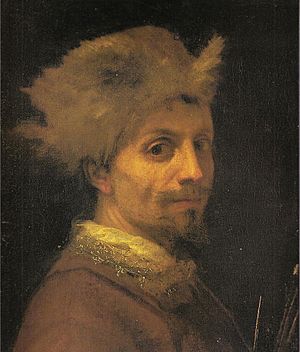Cigoli facts for kids
Lodovico Cardi (born September 21, 1559 – died June 8, 1613), also known as Cigoli, was an Italian painter and architect. He lived during the late Mannerist and early Baroque art periods. Cigoli started his art training and career in Florence, Italy. He spent the last nine years of his life working in Rome.
Cigoli was born in a village called Villa Castelvecchio in Cigoli, Tuscany. This is where he got the name everyone knows him by. He first trained in Florence with a painter named Alessandro Allori, who used a style called Mannerism. Later, Cigoli was influenced by other important painters like Santi di Tito and Barocci. He then changed his style to be more expressive and emotional, moving away from the Mannerist style. This made his later paintings stand out from other Florentine art of the 1500s.
For a wealthy Roman art buyer named Massimo Massimi, Cigoli painted an Ecce Homo (which means "Behold the Man"). This painting is now in the Palazzo Pitti museum. Interestingly, two other famous painters, Passignano and Caravaggio, were also asked to paint the same scene without knowing about each other. Later, the French leader Napoleon took Cigoli's Ecce Homo to the Louvre museum in Paris. It was returned to Florence in 1815.
One of Cigoli's early paintings showed Cain slaying Abel. He then worked for the Grand-Duke, painting several pieces for the Pitti Palace. These included a Venus and Satyr and a Sacrifice of Isaac.
Other important paintings by Cigoli include St. Peter Healing the Lame Man in St Peter's Basilica in Rome. He also started a painting called Burial of St. Paul for the church of San Paolo fuori le Mura, but it was not finished. He painted a Story of Psyche as a fresco (a painting on wet plaster) in the Villa Borghese. His Martyrdom of Stephen was so good that people called him the "Florentine Correggio" (after another famous painter). He also painted a Stigmata of St. Francis in Florence. Not long before he passed away, Cigoli was given a special honor called Knight of Malta by Pope Paul V.
A famous painter from the 1600s, Andrea Sacchi, said that Cigoli's "St Peter Healing the Lame Man" was one of the most beautiful paintings in Rome. Even before he came to Rome, Cigoli was so well-known that the Florentine ambassador welcomed him to the city. In a book about artists called Notizie by Baldanucci, Cigoli is one of only two artists, along with Michelangelo, to be called "Divine."
Cigoli was a close friend of the famous scientist Galileo Galilei. Galileo even thought Cigoli was the greatest painter of his time. Cigoli painted his last fresco in the dome of the Pauline chapel in the church of Santa Maria Maggiore in Rome. This painting shows the Madonna standing on a moon that has craters and marks. This is the first time an artist showed the moon as Galileo described it in his book, Sidereus Nuncius. Before this painting, the moon in art was always shown as perfectly smooth and mythical, as people believed for a long time.
Cigoli taught many students who became artists themselves. Some of his pupils were Cristofano Allori (1577–1621), Giovanni Biliverti (1576–1644), Domenico Fetti, Giovanni Antonio Lelli, Aurelio Lomi, Pietro Medici, Gregorio Pagani, and Andrea Comodi (1560–1638).
See also
 In Spanish: Cigoli para niños
In Spanish: Cigoli para niños



